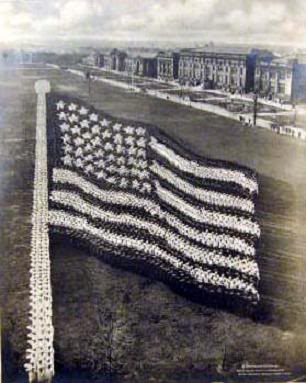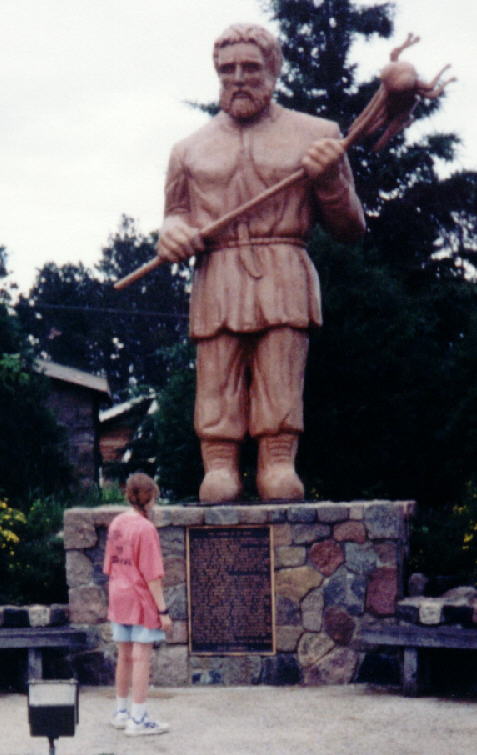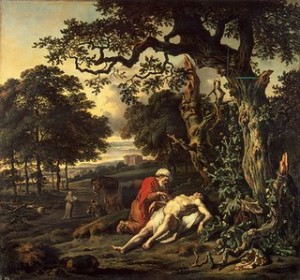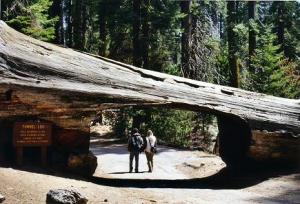
from Flag Day Part I
A few weeks later, on June 4, 1917, Kimber presented the flag in a more somber ceremony, largely for the American Ambulance Corps volunteers who were already stationed near Treveray, France.
“My instructions were to bring the flag as quickly as I could, and that I have done to the best of my ability. You know the history of this flag: how it was dedicated and blessed in California; how it led a parade in New York down Fifth Avenue before thousands of persons, and how it was saluted and cheered by that vast multitude; how an attempt to capture it was frustrated; how it reposed in the chancel of Old Trinity Church and was there seen and prayed for by hundreds; and how it was carried through England on its way to France.”
The ceremony ended in a promise by a military official that the defeat of German tyranny would “assure for all time the victory of right, of justice, and of liberty.”
Later that year Kimber realized his dream. He earned his wings as a pilot with the U.S. Air Service.
On June 15, 1918, the day after flag day and a year after his initial speech, he learned that his best friend from back home, Alan Nichols, had been killed behind enemy lines. He weeped for his friend, that war would take such a good man, unaware that in a few short months he would meet a similar fate.
On September 14th, Kimber had a particularly close mission, in which his plane was shot up almost beyond repair. But “The three vital parts—my engine, the gas tank, and I—were untouched,” he wrote home the following day. He concluded his letter with the words,
“God was merciful to me; I hope I can prove myself worthy of His mercy in this war and in later life. Well I must quit; good-bye, good luck and lots of it and much love. God bless you all.”
Eleven days later, God was not so merciful. A month and a half before the Armistice ended the “War To End All Wars,” Kimber’s plane was shot down along the German lines.
“That war insistently devours such men as Clifford Kimber is its final indictment at the bar of civilization” — David Starr Jordan
* * *
Woodrow Wilson noted the importance of the flag in times of peace as well as war. But make no mistake, it’s always been war that has given flags their import. As Francis Scott Key wrote:
And the rockets’ red glare, the bombs bursting in air,
Gave proof thro’ the night that our flag was still there.
Flags are born of war, defended in war, have perished in war. Our almost religious devotion to these pieces of fabric is largely due to the intangible and unpayable debt to those who gave their lives defending them.
It was during wartime that a group of traitors rebelling against the English crown sat down and adopted the flag, a symbol of what the newly united states were fighting for. Betsy Ross and the founders broke from European tradition by not placing the cross or overtly religious symbols on their banner. Instead they instituted a design that would make the U.S. flag unique.
Before June 1777, other Americans had placed 13 stripes on their flags, representing the 13 colonies, and a British Union Jack in the corner. But where the Union Jack had been, Ross and the founders placed a circle of 13 stars. A little redundant perhaps, but this allowed for the possibility of adding new stars to the flag for new states as the Union expanded.
As the number of states increased, so did the number of stars. Today, one can view the U.S.’s 230+ year history in a single glance. Always stars and stripes, always red, white and blue. But changing slowly to reflect the changing country, just like the Constitution.



Would the representatives of the 13 fledgling states that banded together in 1777 recognize the 50-star Mega-State that we know today? Perhaps not.
Would they recognize the flag?
In a moment.
On the shore dimly seen thro’ the mists of the deep,
Where the foe’s haughty host in dread silence reposes,
What is that which the breeze, o’er the towering steep,
As it fitfully blows, half conceals, half discloses?
Now it catches the gleam of the morning’s first beam,
In full glory reflected, now shines on the stream:
‘Tis the star-spangled banner: O, long may it wave
O’er the land of the free and the home of the brave!
— Francis Scott Key, the less-recited 2nd verse of the Star-Spangled Banner
The Story of the First Flag : An Account of the Mission of Arthur Clifford Kimber
















